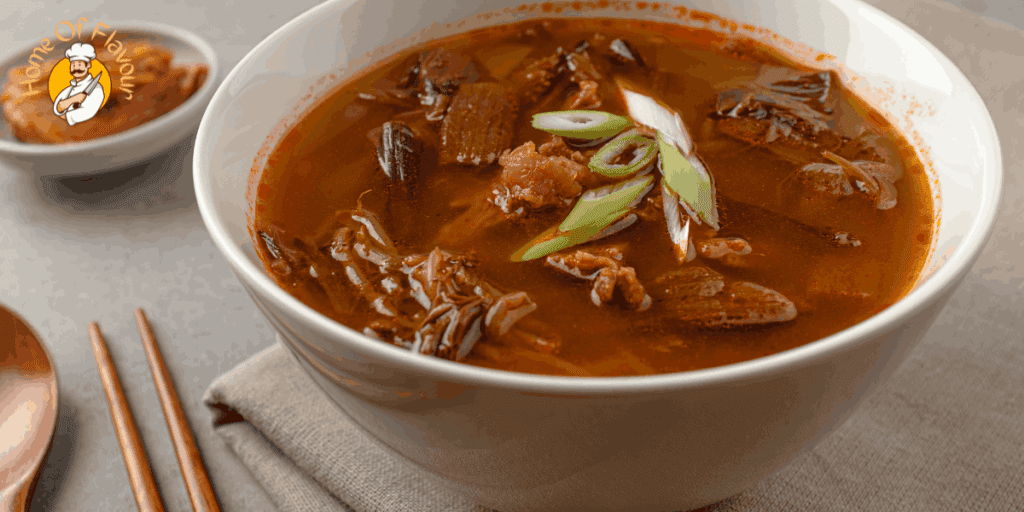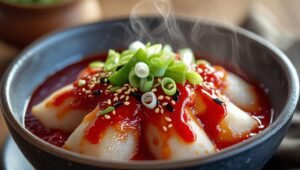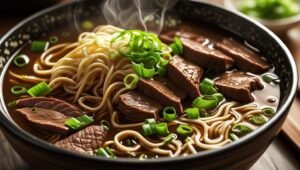Yukgaejang (육개장, 肉개醬): Korean Spicy Beef Soup
Table of Contents
Toggle
Overview
Yukgaejang is a bold, spicy Korean beef soup that’s hearty, comforting, and packed with deep flavors. This dish features tender shredded beef simmered in a rich, savory broth infused with sesame oil, soy sauce, and aromatic spices. Ingredients like fernbrake, bean sprouts, shiitake mushrooms, and green onions add an earthy, well-rounded taste, making it a staple in Korean cuisine. Traditionally served with steamed rice and kimchi, yukgaejang is a nourishing comfort food and a popular stamina-boosting dish year-round.
Why You’ll Love This Recipe
This soup isn’t just about spice—it’s a perfect balance of robust flavors and satisfying textures. The smoky, umami-rich broth pairs beautifully with the tender beef and crisp vegetables, creating an intensely flavorful dish. Whether enjoyed on a cold winter day or as a revitalizing meal in the summer, yukgaejang is both comforting and invigorating. Plus, it’s packed with protein and nutrients, making it an excellent choice for a wholesome meal.

Ingredients You’ll Need
Main Ingredients
- Beef – 1 lb brisket (or flank steak, shank meat) – Provides a rich, meaty base.
- Green Onions – 75g (14-16 stalks) – Adds freshness and subtle sweetness.
- Mushrooms – 95g fresh shiitake (or 3 dried shiitake) – Infuses earthy depth.
- Fernbrake – 100g hydrated fernbrake – Contributes a unique, slightly nutty flavor.
Aromatics & Seasonings
- Garlic – 1 tbsp, minced – Enhances the broth’s aroma.
- Black Pepper – 1 tsp – Adds warmth and depth.
- Sesame Oil – 2 tbsp – Essential for a rich, nutty undertone.
- Soy Sauce – 1 tbsp – Brings umami and saltiness.
- Olive Oil – 1 tbsp – Adds a touch of richness.
- Kosher Salt – Adjusts seasoning to taste.
- Red Chili Paste – 1 tsp – Adds a deep, spicy kick.
- Chili Flakes – 2 tbsp – Brings heat and vibrant color.
Vegetables & Noodles
- Mung Bean Sprouts – 8 oz – Provides crunch and freshness.
- Glass Noodles – 3 oz, soaked for 20 min – Adds a chewy texture.
- Eggs – 2, lightly beaten – Creates richness in the broth.
Broth & Serving
- Water – 10 cups – Forms the base of the soup.
- Fine Sea Salt, Extra Kosher Salt, & Ground Black Pepper—For final seasoning adjustments.
- Steamed Rice – Served on the side for a complete meal.

How to Make Yukgaejang
Step 1: Prepare the Broth & Meat
- In a large pot, bring 12 cups of water to a boil.
- Add beef brisket, dried shiitake mushrooms, and an onion.
- Once boiling, reduce to medium-high heat and let it simmer for 1 hour.
- Meanwhile, mix all seasoning ingredients in a bowl, cover, and set aside.
Step 2: Check the Beef & Strain the Broth
- After an hour, test the beef by pulling a piece apart with a fork. If it shreds quickly, it’s ready. If not, simmer for another 10 minutes.
- Strain the broth, reserving 7.5 to 8 cups of liquid (add more water if needed).
- Remove the beef, mushrooms, and onion. Discard the onion.
- Shred the beef into thin strips and drain the mushrooms.
Step 3: Add Vegetables & Simmer
- Return the broth to a boil and add mung bean sprouts, green onions, and fernbrake.
- Stir in the seasoning sauce prepared earlier.
- Let everything simmer for 20 minutes, ensuring the vegetables stay tender but not overcooked.
Step 4: Final Touches & Serving
- Add noodles and beaten eggs during the last few minutes for extra texture.
- Adjust seasoning with salt and black pepper as needed.
- Garnish with fresh scallions and serve hot with steamed rice and kimchi on the side.

Serving & Storing Yukgaejang
- Serve piping hot in bowls, garnished with extra green onions.
- Pair with rice and kimchi for a balanced, traditional meal.
- Leftovers? Let the soup cool completely before storing it in an airtight container.
- Fridge: Keeps for up to 4 days.
- Freezer: Store in portions for up to 1 month.
- Reheat on the stovetop or microwave, adding a water splash to revive the broth.
More Korean Comfort Foods to Try!
If you love yukgaejang, here are some other comforting Korean dishes you might enjoy:
- Soft Tofu Stew – A spicy and hearty stew with tofu, seafood, or pork.
- Short Rib Soup – A mild and nourishing beef short rib soup.
- Ginseng Chicken Soup – A nutritious chicken soup traditionally eaten for stamina.
Final Thoughts
Yukgaejang is more than just a spicy soup—a profoundly satisfying dish packed with flavor, nutrition, and heartwarming comfort. Whether you’re new to Korean cuisine or a longtime fan, this dish is sure to impress. Enjoy it on a chilly day or whenever you crave a bold, nourishing meal!
Yukgaejang: (FAQs)
1. Is Yukgaejang Very Spicy?
Yes, yukgaejang is naturally spicy due to red chili paste and chili flakes. However, you can adjust the spice level by reducing the amount of chili flakes or substituting with mild paprika for less heat.
2. Can I Make Yukgaejang with Chicken Instead of Beef?
Absolutely! A variation called chicken yukgaejang uses shredded chicken instead of beef. The cooking process remains the same, but the broth is typically lighter in flavor.
3. What Can I Use Instead of Fernbrake?
If you can’t find fernbrake, substitute it with mushrooms, spinach, or asparagus. While the flavor won’t be the same, these alternatives provide a similar earthy depth.
4. How Can I Make This Soup More Filling?
Adding extra glass noodles or tofu can make the soup heartier. Some people also enjoy stirring in an extra egg for added protein and texture.
5. Can I Make Yukgaejang in Advance?
Yes! The flavors deepen over time, making it even tastier the next day. Reheat gently on the stovetop, adding a splash of water if needed.

Yukgaejang
Equipment
- Large pot (for boiling broth)
- Slotted strainer (for removing beef, mushrooms, and onions)
- Bowl (for seasoning sauce)
- Plastic wrap (for covering seasoning sauce)
- Fork (for checking meat tenderness)
- Knife (for shredding beef)
- Ladle (for serving)
- Airtight container (for storage)
Ingredients
- Beef
- 1 lb brisket/flank/shank – Rich hearty flavor
- Green Onions
- 75 g 14-16 stalks – Fresh, crisp taste
- Mushrooms
- 95 g fresh shiitake / 3 dry – Earthy depth
- Fernbrake Gosari
- 100 g hydrated gosari – Adds earthy notes
- Aromatics & Seasonings
- 1 tbsp garlic – Aromatic boost
- 1 tsp black pepper – Enhances seasoning
- 2 tbsp sesame oil – Rich nutty flavor
- 1 tbsp soy sauce – Umami depth
- 1 tbsp olive oil – Extra richness
- Kosher salt – Adjusts taste
- 1 tsp gochujang – Spicy kick
- 2 tbsp gochugaru – Adds heat & color
- Vegetables & Noodles
- 8 oz mung bean sprouts – Crunch & texture
- 3 oz dangmyeon – Chewy soft texture
- 2 eggs – Extra richness
- Broth & Rice
- 10 cups water – Soup base
- Fine sea salt extra kosher salt, 1/8 tsp black pepper – Seasoning balance
- Rice – Served alongside
Instructions
- Boiling the Broth and Preparing the Meat
- Boil 3 quarts or 12 cups water in a large pot.
- Add beef, dried shiitake mushrooms, and onion.
- Reduce to medium high heat and cook for 1 hour.
- Mix seasoning sauce in a bowl, cover with plastic wrap, and set aside.
- Checking the Beef and Preparing the Broth
- Check beef by pulling a sample chunk with a fork.
- If tough, cook 10 minutes longer.
- Maintain 7.5–8 cups broth by adding water if needed.
- Remove beef, onion, mushrooms with a slotted strainer and cool.
- Discard onion, shred beef, and drain mushrooms.
- Adding the Vegetables and Final Cooking
- Add mung bean sprouts, green onions, gosari to boiling stock.
- Stir in seasoning sauce, cook for 20 minutes until tender but not mushy.
- Add noodles, eggs for extra texture.
- Garnish with scallions, season with salt.
- Serve with rice and kimchi.
- Serving and Storing Yukgaejang
- Serve hot in bowls with rice, kimchi.
- Garnish with scallions, add salt if needed.
- Store in an airtight container in the fridge (4 days) or freeze (1 week, in portions).
- Reheat and enjoy as the flavors deepen over time.




